A summary of my travels between Apr-Jun 2019
I have now completed eight months or 33% of my planned two year trip. As with my previous trip summaries, I will attempt to give you a flavour from the locations I have visited, rather than delve deeply into the details.Nong Khai (Thailand)
From Vientiane in Laos it is only a 1 hour short bus ride journey over the friendship bridge into the north-east of Thailand and the town of Nong Khai.There are Laos flags on the first half of the friendship bridge and then as soon as you cross the halfway point, flags turn into the Thai national flag. There is clearly more development on the Thai side of the Mekong river where a new promenade is being constructed and new bars and restaurants are popping up along its banks.Being a border town, trade with Laos is a big part of the local economy. There really isn't a huge amount to do apart from visiting a few temples and a Buddha Park which was created by the same designer as the one I visited in Laos.As tourists are very thin on the ground, restaurants and bars tend not to have their menus in English, and so in reality, only cater to Thai's. This results in life being more genuine and interesting when interacting with locals.Udon Thani (Thailand)
A short 2 hour journey in a minivan for just over £1 brings me to my next stop in Eastern Thailand. There isn't a huge variety of activities as this is a working city which mainly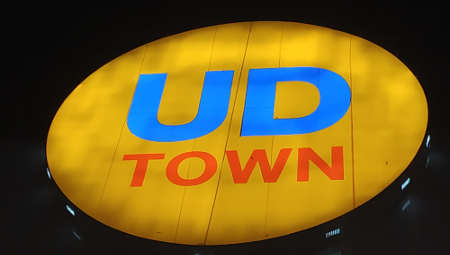 revolves around trade again in the huge night market that dominates the centre of town. The town does however have a place in my heart as it has the initials of my name used extensively.A walk around Nong Prajak Public Park was enjoyable, taking around two hours and burning a few calories in the 100+ degree heat. We recorded 17,000 footsteps according to a friend I was fortunate to meet up with again. The nice hostel I was staying at was charging just under £8 per night for a bed in a dorm. I decided to get my own room in a hotel for £10 as the hostel was empty anyway so socialising was non existent.The huge night market is where the majority of people hang out after sunset with it's large choice of stalls selling everything including a huge selection of street food and fruit shakes.A particular favourite hangout for me was the Bitcoin bar & restaurant which had live music every night with multiple local bands and extremely cheap beer.....strangely, they did not accept bitcoin!I find myself in Udon Thani during the Thai New Year. Songkran, also known as the water festival, is the ritual of washing away negativity from your life from the previous year. Most Thai's use this 3 day national holiday to spend time with their family. Street parties with loud music, inflatable swimming pools, water guns, hoses and huge plastic barrels filled with ice water are the required tools for a traditional Songkran celebration. Another favourite option is to fill the back of a pickup truck with a huge plastic barrel or two, full of water and your family.....yes small kids too, then everyone needs to be ready to get others as wet as possible as you drive past people on the pavement and on scooters. As I leave my hotel in the evening and join the main road, I can see what lies ahead......water everywhere. As I walk along the pavement, I successfully manage my first obstacle, a man with a bucket decides to have mercy on the foreigner and lightly drips water over my head. Further down the road, another chap came up to me with two buckets of water, I tried to negotiate, but he wasn't having it. I ended up tipping both buckets over him as this seemed my only option......I quickly ran away, only for his son to spray me from a huge water hose.....I ended up drenched anyway. A couple of kids further on sprinkled me with water, as I turned my back, they poured a whole bucket over my head. At this point I decided to join the big Songkran Festival Party. It was only 100 Thai Baht or £2.50 to enter the stadium. There must have been a few thousand people dancing to the music. It was extremely friendly, but not crazy, with people wishing each other happiness, someone even gave me a beer. What was amazing was the constant water coming down from above and the water cannons being used for a friendly purpose......thank you Thailand and happy New Year.
revolves around trade again in the huge night market that dominates the centre of town. The town does however have a place in my heart as it has the initials of my name used extensively.A walk around Nong Prajak Public Park was enjoyable, taking around two hours and burning a few calories in the 100+ degree heat. We recorded 17,000 footsteps according to a friend I was fortunate to meet up with again. The nice hostel I was staying at was charging just under £8 per night for a bed in a dorm. I decided to get my own room in a hotel for £10 as the hostel was empty anyway so socialising was non existent.The huge night market is where the majority of people hang out after sunset with it's large choice of stalls selling everything including a huge selection of street food and fruit shakes.A particular favourite hangout for me was the Bitcoin bar & restaurant which had live music every night with multiple local bands and extremely cheap beer.....strangely, they did not accept bitcoin!I find myself in Udon Thani during the Thai New Year. Songkran, also known as the water festival, is the ritual of washing away negativity from your life from the previous year. Most Thai's use this 3 day national holiday to spend time with their family. Street parties with loud music, inflatable swimming pools, water guns, hoses and huge plastic barrels filled with ice water are the required tools for a traditional Songkran celebration. Another favourite option is to fill the back of a pickup truck with a huge plastic barrel or two, full of water and your family.....yes small kids too, then everyone needs to be ready to get others as wet as possible as you drive past people on the pavement and on scooters. As I leave my hotel in the evening and join the main road, I can see what lies ahead......water everywhere. As I walk along the pavement, I successfully manage my first obstacle, a man with a bucket decides to have mercy on the foreigner and lightly drips water over my head. Further down the road, another chap came up to me with two buckets of water, I tried to negotiate, but he wasn't having it. I ended up tipping both buckets over him as this seemed my only option......I quickly ran away, only for his son to spray me from a huge water hose.....I ended up drenched anyway. A couple of kids further on sprinkled me with water, as I turned my back, they poured a whole bucket over my head. At this point I decided to join the big Songkran Festival Party. It was only 100 Thai Baht or £2.50 to enter the stadium. There must have been a few thousand people dancing to the music. It was extremely friendly, but not crazy, with people wishing each other happiness, someone even gave me a beer. What was amazing was the constant water coming down from above and the water cannons being used for a friendly purpose......thank you Thailand and happy New Year.Khon Kaen (Thailand)
This town is just under two hours south of Udon Thani with the mini bus dropping me at the terminal 3 coach station which is a cheap £2.50 taxi ride to the centre of town where you'll most likely stay as I did.The Wat Nong Wang Temple is pretty impressive, affording a great view of the city after having climbed it's seven stories. Bueng Kaen Nakhon Lake is also worth a walk around its 3km circumference.....better early morning or evening to avoid the heat, unless you want it all to yourself as I did around 2pm.As the Songkran/Thai New Year festivities are still going on, it would be unfriendly not to take part. My walk into the centre of town was strangely uneventful. I lost count of the number of pick-up trucks with families & friends in the rear with hoses and water cannons.My reprieve however was short-lived as I arrive at the main road. It was as long as Oxford Street in London, with pop up tents, stages, stalls and bars on either side. Water cannons, hoses or just buckets of ice cold water being thrown into the crowd walking through the centre of the road, we were all easy and willing targets.Everyone pretty quickly ends up drenched, you just hope that the water landing on you is not the ice cold variety as even in 90 degree heat it sends a shiver down your spine.This has to be the most friendly street party I have ever attended in my life. Everyone is happy, taking their time to have fun with not an ounce of trouble in the air........how refreshing.Talcum powder mixed with water to form a white paste is also used. It is a sign of protection and promises to ward off bad luck. I must have had at least 50 people smear my face as we passed each other, they did this with a warmth of heart I have never experienced before.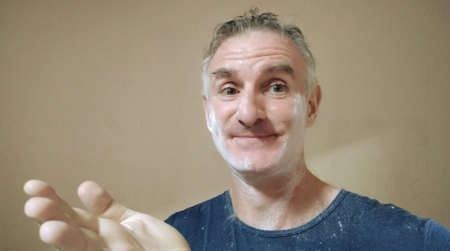 Some of the more trendy bars had live bands which were clearly popular with hoards of young girls screaming at their performance.Songkran is such an amazing experience, I hope some of you get to take part when visiting Thailand. It takes place between 13-15th April, a 3-day national holiday but actually extends to 5 days. In some other parts of Thailand they extend the festival even further.Be ready to get drenched and prepare appropriately, ideally leaving your valuables and mobile phone back at the hotel. Simply carry some cash in a sealed bag or purchase a dry bag for your valuables or protective cover for your phone so you can take photos.
Some of the more trendy bars had live bands which were clearly popular with hoards of young girls screaming at their performance.Songkran is such an amazing experience, I hope some of you get to take part when visiting Thailand. It takes place between 13-15th April, a 3-day national holiday but actually extends to 5 days. In some other parts of Thailand they extend the festival even further.Be ready to get drenched and prepare appropriately, ideally leaving your valuables and mobile phone back at the hotel. Simply carry some cash in a sealed bag or purchase a dry bag for your valuables or protective cover for your phone so you can take photos.Nakhon Ratchasima (Thailand)
I was fortunate to be able to jump onto a coach immediately on arriving at the terminal 3 bus & coach station as today was still a national holiday. The £2.78, 4 hour journey on the VIP bus went through some beautiful countryside on the way south.I decided to stay in the old part of town and having had a brief walk around in the afternoon was pretty underwhelmed. Admittedly, it was still a national holiday today so everything was shut. The town wasn't historic in anyway apart from a few beautiful temples. Not really much to do in this town so just caught up with some reading and writing, therefore never really at a loss.Phimai (Thailand)
A short 1 hour "chicken" bus ride to the village of Phimai with it's historical ruins pre-dating those of Angkor Wat in Cambodia is my next stop.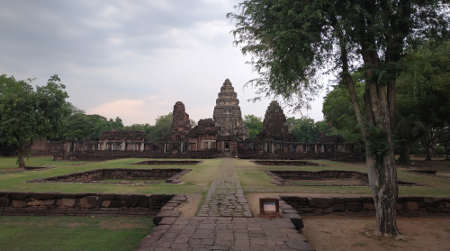 The main site in the centre of town can be completed in an hour or so. I visit in the morning and then headed off to the famous Sai Ngam Banyan Tree Grove on the edge of town. For sunset I decide to return to the main ruins, within a few minutes a huge thunderstorm develops and starts to pour down. I take shelter in the main temple as the rain is pounding down, I was there for over 30 minutes and it was an amazing surreal experience. It turns out I was the only person that remained, as I came out, the security guard smiled at me and with his hands in the shape of a roof sign to indicate that I sheltered underneath the main temple......I nodded yes. I figured it was safe having been around for a few years! This was extremely accurate, as I was about to find out.If I had left the temple earlier as planned to go to the night market, my experience would have been somewhat different. Surrounding the market was a wall of corrugated metal fencing that had been literally thrown all over the place as lightning struck. Many stallholders were pretty shook up and had decided to pack up and go home early.....I'm not surprised, lightning had struck only 10 feet from their stalls. The main bar on the corner also had its metal corrugated roof destroyed with a huge hole created by a thunder strike. As there was no power in town I decided to have a few cold beers at this bar and talk over the days happenings and life with a French expat who had been living just outside of Phimai for over 30 years.
The main site in the centre of town can be completed in an hour or so. I visit in the morning and then headed off to the famous Sai Ngam Banyan Tree Grove on the edge of town. For sunset I decide to return to the main ruins, within a few minutes a huge thunderstorm develops and starts to pour down. I take shelter in the main temple as the rain is pounding down, I was there for over 30 minutes and it was an amazing surreal experience. It turns out I was the only person that remained, as I came out, the security guard smiled at me and with his hands in the shape of a roof sign to indicate that I sheltered underneath the main temple......I nodded yes. I figured it was safe having been around for a few years! This was extremely accurate, as I was about to find out.If I had left the temple earlier as planned to go to the night market, my experience would have been somewhat different. Surrounding the market was a wall of corrugated metal fencing that had been literally thrown all over the place as lightning struck. Many stallholders were pretty shook up and had decided to pack up and go home early.....I'm not surprised, lightning had struck only 10 feet from their stalls. The main bar on the corner also had its metal corrugated roof destroyed with a huge hole created by a thunder strike. As there was no power in town I decided to have a few cold beers at this bar and talk over the days happenings and life with a French expat who had been living just outside of Phimai for over 30 years. Ayutthaya (Thailand)
A rather long and haphazard journey taking multiple buses has me arriving at another significant cultural centre. This was the former capital city of Thailand which was known as Siam and interestingly never under colonial rule.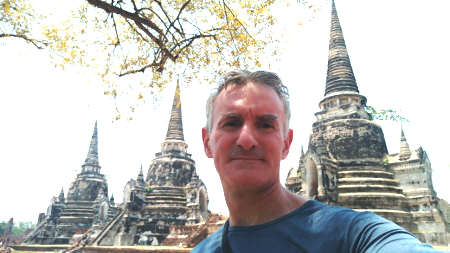 Numerous ruins are spread out around this UNESCO heritage town. Don't be fooled by the cute tourist maps, distances between sites are lengthy and not fun in the 103+ degree heat. It's best not to walk around as I did, instead, hire a bicycle/moped or negotiate with a tuk tuk. The hugely popular night market has a great selection of street food and well worth a visit and with fresh fruit shakes priced at 55p what's not to like.
Numerous ruins are spread out around this UNESCO heritage town. Don't be fooled by the cute tourist maps, distances between sites are lengthy and not fun in the 103+ degree heat. It's best not to walk around as I did, instead, hire a bicycle/moped or negotiate with a tuk tuk. The hugely popular night market has a great selection of street food and well worth a visit and with fresh fruit shakes priced at 55p what's not to like.Bangkok (Thailand)
The journey south to Bangkok is only an hour and a half and only 55 km, the traffic however as you approach Bangkok is significant. I arrive at Mo Chit in the north and then take a local bus. I firstly board the wrong bus (blame Google), heading south towards the Khao San Road area. This is a famous backpacker hangout area but my first time in this part of Bangkok.Khao San Road, is full of late night bars each pumping out serious volumes of sound. They remind me of the bars at party resorts on the Spanish & Greek islands. Fortunately there is more to this area. A parallel road immediately to the north, has a calmer atmosphere with restaurants & bars having live music instead. One particular bar was pretty much the reserve of local Thai's. I was the only Westerner with the live bands pumping out mainly Thai ballads which I strangely enjoyed. My huge Mai Tai cocktail bucket for the price of a London pint kept me going for a quite a while. In fact a table nearby with four young guys was consuming their bucket only slightly bigger than mine at such a slow pace it was embarrassing.....or maybe I have the problem!I moved to another hostel which was absolutely stunning, a restored merchants home, one of the best I've stayed at. Located in the old part of Bangkok, on a canal and near the original flower market. Full of life during the day, but by night time, a ghost town. So much so, that finding a restaurant or any type of food was really hard. It was also my first time visiting the two main floating markets in Bangkok. They are open on Saturdays and Sundays only and are outside of Bangkok. Many websites advise you to go to Wongwian Yai station and then hail a taxi.
A parallel road immediately to the north, has a calmer atmosphere with restaurants & bars having live music instead. One particular bar was pretty much the reserve of local Thai's. I was the only Westerner with the live bands pumping out mainly Thai ballads which I strangely enjoyed. My huge Mai Tai cocktail bucket for the price of a London pint kept me going for a quite a while. In fact a table nearby with four young guys was consuming their bucket only slightly bigger than mine at such a slow pace it was embarrassing.....or maybe I have the problem!I moved to another hostel which was absolutely stunning, a restored merchants home, one of the best I've stayed at. Located in the old part of Bangkok, on a canal and near the original flower market. Full of life during the day, but by night time, a ghost town. So much so, that finding a restaurant or any type of food was really hard. It was also my first time visiting the two main floating markets in Bangkok. They are open on Saturdays and Sundays only and are outside of Bangkok. Many websites advise you to go to Wongwian Yai station and then hail a taxi. This however is old information, as the train line has been extended. I went to the furthest station called Bang Wa and then caught a taxi for around £2.The first market is Khlong Lat Mayom Floating Market which surprisingly doesn't have many actual boats that people trade from. It is however interesting just walking around the canals or you can take a boat tour. It is a good place to have lunch as there are so many food stalls and restaurants along the canal with extensive choices. Another taxi ride to the second market - Taling Chan Floating Market, once again had a lack of boats, it's really about the land market.One of the reasons for posting my itinerary online is to allow friends to see where I will be. This worked out particularly well on this occasion as I was able to adjust my plans by just a few days in order to meet up with some friends from London visiting Bangkok. It was great to catch up and spend an evening together which ended up being great fun.
This however is old information, as the train line has been extended. I went to the furthest station called Bang Wa and then caught a taxi for around £2.The first market is Khlong Lat Mayom Floating Market which surprisingly doesn't have many actual boats that people trade from. It is however interesting just walking around the canals or you can take a boat tour. It is a good place to have lunch as there are so many food stalls and restaurants along the canal with extensive choices. Another taxi ride to the second market - Taling Chan Floating Market, once again had a lack of boats, it's really about the land market.One of the reasons for posting my itinerary online is to allow friends to see where I will be. This worked out particularly well on this occasion as I was able to adjust my plans by just a few days in order to meet up with some friends from London visiting Bangkok. It was great to catch up and spend an evening together which ended up being great fun.Siem Reap (Cambodia)
Having not booked my travel in advance, I head to the Khao San area early in the morning hoping to catch a bus to Siem Reap. I only find one travel agency open, they make a quick phone call and within 20 minutes I'm inside a minivan and on my way.I was told the journey would take around 7 hours on the same big bus, the reality however was somewhat different. A motorbike turns up to take me to a minivan about a mile away, I then wait for other passengers to board. we were told this minivan would take us to a big bus. This was technically correct, but not until we got to the Thai/Cambodian border over 4 hours later. We are then taken to a Thai restaurant and are told that we will have to wait for other people to arrive before continuing. I became suspicious when we were individually taken to separate tables by a team of people. Clearly they wanted us separated and no longer as part of a group. The official Cambodian visa is US$30, this team said they would expedite us through the whole process and get the visa sorted for an additional fee which we would have to pay anyway at the border. Those that refused were told to walk themselves to the border which was about 2 miles down the road in 40 degree heat!Welcome to Cambodia.....the scams did not end there. On the other side of the border we board another bus which eventually arrives to Siem Reap.......but 4 kilometres outside the centre. Fortunately we are told that free tuk tuks were waiting for us which will take us to the centre of town. On boarding, the drivers wanted to be our tour guides around the temples. If refused, they would charge us for the journey into the centre......welcome again to Cambodia. These mafia tactics need to be addressed as they have been in other tourist hotspots around the world.Having said all of the above, Siem Reap is another of my favourite places having been here 6 years ago, despite it being full of tourists because of the famous ancient ruins. The town has something to offer everybody from backpacker hostels to boutique hotels and large resorts. The multitude of restaurants & bars keeps everyone happy especially where a mug of beer, roughly 330ml in size, costs only 38p which is the same price as 6 years ago.The old ticket office for the ruins used to be a small building on the edge of Angkor Wat; now it's a huge concrete building on the outskirts of town with 48 ticket booths.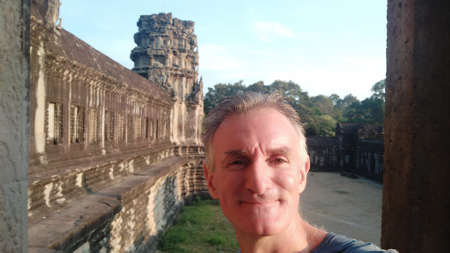 This alone shows the expansion of tourism. A 1-day ticket is US$37, 3-day US$63 and a 1-week, US$73. Many of the hotels & hostels offer a sunrise and sunset tour where you see 4/5 of the famous temples in a shared tuk tuk. Alternatively, you can hire your own driver for around US$15-20 per day and create your own itinerary. Tuk tuk's are available everywhere around town, you'll be constantly asked if you need a tour guide or just a taxi. Prices are negotiable, but often on the high side. An alternative is to download the Pass Cambodia App which gives you access to motorbike & tuk tuk taxis similar to Grab in other parts of Asia or Uber in the West. It is possible to see 9/10 of the most famous ruins in 1 day, however, the 100+ degree heat makes the day a very exhausting one.
This alone shows the expansion of tourism. A 1-day ticket is US$37, 3-day US$63 and a 1-week, US$73. Many of the hotels & hostels offer a sunrise and sunset tour where you see 4/5 of the famous temples in a shared tuk tuk. Alternatively, you can hire your own driver for around US$15-20 per day and create your own itinerary. Tuk tuk's are available everywhere around town, you'll be constantly asked if you need a tour guide or just a taxi. Prices are negotiable, but often on the high side. An alternative is to download the Pass Cambodia App which gives you access to motorbike & tuk tuk taxis similar to Grab in other parts of Asia or Uber in the West. It is possible to see 9/10 of the most famous ruins in 1 day, however, the 100+ degree heat makes the day a very exhausting one.Battambang (Cambodia)
This is the second most populated city in Cambodia but walking around its centre you would not come to this impression. Many French colonial buildings still remain, despite showing signs of decay.The peace monument made by Cambodian artists to represent the future the country wants to symbolise, was constructed from artillery remnants a poignant reminder of the past.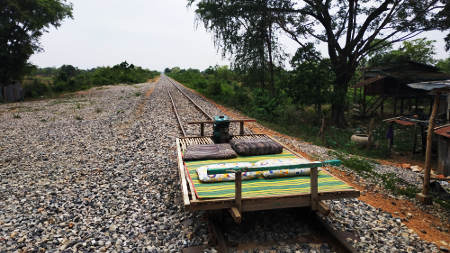 A ride on a railway track in a bamboo cart with the possibility that an actual train could come down the track at any time, as happened the previous day, was one of the highlights. A visit to another bat cave was also pretty special as over 16 million bats leave their home and make stunning shapes in the sky as they head out to feast in unison.
A ride on a railway track in a bamboo cart with the possibility that an actual train could come down the track at any time, as happened the previous day, was one of the highlights. A visit to another bat cave was also pretty special as over 16 million bats leave their home and make stunning shapes in the sky as they head out to feast in unison.Phnom Penh (Cambodia)
The last time I was in Phnom Penh was just over 6 years ago and what a transformation it has undergone. The main promenade along the river bank has been completely renovated with trees and lighting and a new section heading south with a multitude of dining options and a children's fairground. The skyline is filled with cranes and skyscraper apartments and office buildings clearly showing an influx of investment.New trendy restaurants and coffee shops have sprung up around town, but delve a little deeper inland and away from the riverfront, around the old town and you will see little has changed with people living a gritty hard working life. The average wage in Cambodia is around US$200 per month with a semi-decent job bringing in around US$300. Interestingely, my daily expenditure on a hostel bed alone is equivalent to this daily wage.The 50 cent per mug beer along the riverfront restaurants and bars has however disappeared with inflation causing it to rise to 75 cents per mug......oh dear.... although it can still be found further inland away from the river. My favourite bar called "River Crown" opposite the Foreign Colonial Club still has a happy hour, fortunately it has expanded from 4 to 8 p.m. with its excellent cocktails now $2.50 each. Live music every night draws in a large following of local Cambodians. This is a good sign, as 6 years ago it was mainly Westerner's frequenting this riverfront bar & restaurant.
although it can still be found further inland away from the river. My favourite bar called "River Crown" opposite the Foreign Colonial Club still has a happy hour, fortunately it has expanded from 4 to 8 p.m. with its excellent cocktails now $2.50 each. Live music every night draws in a large following of local Cambodians. This is a good sign, as 6 years ago it was mainly Westerner's frequenting this riverfront bar & restaurant.Sihanoukville/Otres Beach (Cambodia)
Last time I was at this sleepy beachfront town, the atmosphere was very chilled and relaxed. It is now however, a "Special Economic Zone" with huge amounts of inward investment pouring in. This was evident as my bus arrives in town and a huge number of lorries with cement and other building materials were clogging the main road. Sihanoukville has been transformed into a casino and hotel resort town equivalent to Macau in China, in fact it's become known as "Mini Macau". Most of the investment is from China with pretty much all of the hotel's having Chinese names.Sihanoukville is now a frontier town, the wild west, I must have seen at least 60 cranes each completing a new high rise building. Tuk tuks compete with £100,000 Chinese owned Range Rovers around town. Even the backpacker haven of Otres Beach, 10 kilometres south, seems to be succumbing to the high-rise condo & casino developments. Many of the independent popular bars, restaurants & hostels that make Otres Beach unique, are either selling up, shutting down or changing their business model to accommodate Chinese tourists instead of backpackers. What a shame or is this just the market deciding the future?The local population seems to mainly consist of construction male workers who head to the beach at sunset to unwind from a hard day's work with some beers and street food purchased from nearby vendors.Koh Ta Kiev (Cambodia)
The 1 hour boat ride on board a narrow supply boat was pretty uneventful as the sea was pretty calm. Upon arriving at The Last Point Hostel, we all received a warm welcome from the Canadian owners Jordan and Justin. I took part in what's known as the Klang 30 challenge. You buy one can of Klang beer and have 30 minutes to finish as many cans as possible free of charge. I believe the record is 11 cans, I only managed a fraction of that number. It was however, a great icebreaker for the new arrivals. The island had a touch of Fantasy Island about it, as guests already on the island eagerly await the boat to see who will be joining the group.Life on the island is very simple, there is no wifi, no running water, limited electricity, toilets are the composting variety, the shower consists of pouring a bucket of cold water over oneself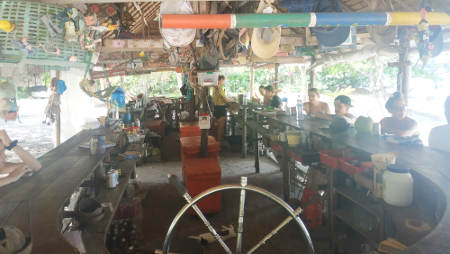 and the dorms are pitch black from around 7 p.m. The experience has a touch of the Robinson Crusoe about it. Days are spent walking along the beach, chilling at the bar getting to know each other, reading books or trekking to other parts of the island through some pretty overgrown areas in the humid climate.Life here was so simple, and it was nice to take a break from the modern world of the internet and electronic gadgets.
and the dorms are pitch black from around 7 p.m. The experience has a touch of the Robinson Crusoe about it. Days are spent walking along the beach, chilling at the bar getting to know each other, reading books or trekking to other parts of the island through some pretty overgrown areas in the humid climate.Life here was so simple, and it was nice to take a break from the modern world of the internet and electronic gadgets.Taipei (Taiwan)
Arriving in Taipei I reflect on the previous 7 months in what I call the traditional southeast Asian countries, which to some extent, are similar. I now start a different journey where the history, culture and pretty much everything else is very different.As I catch a bus from the airport to the centre of town I immediately see the difference. I have Wi-Fi on the bus that departs on time and I can see the skyscrapers in the distance, this immediately feels more western. I check in to my hostel and head out to get some food, but I'm surprised that many restaurants where closing around 9 p.m., I did manage to find one place however.The weather for my first day in Taipei was predicted to rain until the early evening, the forecast was correct. I head out in the evening once the thunderstorms had passed to get my first impression of Taipei.Lunch the next day was at a vegetarian buffet restaurant. I sit next to an old lady telling me that I must have stolen someone's daughter due to the many visible mosquito bites on my arms from my time on the island. She briefly suggests I should visit a doctor and then continued to talk with another lady.I feel Taipei is an easy introduction to this part of the world. Taipei has around 6 million inhabitants, while Tokyo has 5/6 times more and I suspect, a more crazy vibe. Bright lights and neon signs aside, the city is very relaxed with no loud music or people shouting and little traffic noise. Very civilized and pretty sedated.There doesn't appear to be a western drinking culture here, apart from special occasions or a big family gathering at a restaurant. Just like other parts of Asia everything seems to revolve around eating and shopping. To find a bar selling alcohol is actually very difficult, what you think is a bar, turns out to be a coffee/tea cake shop. The bars that do exist, seem to be of the underground sleazy gentleman variety.It feels a very safe city to walk around in, even at night. Everything is more expensive than Thailand with an average lunch costing around £3-4 pounds and dinner £8-10 pounds and beer being close London prices.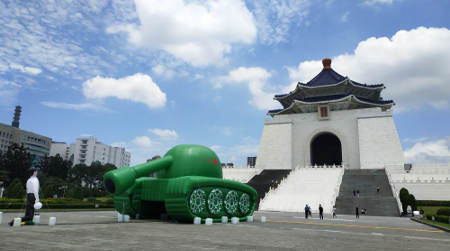 At the Memorial Hall Park in the centre of town there was an inflatable 30ft tall tank with a person staring up it's nozzle.....a clear reference to the 30th anniversary of Tiananmen Square or as China prefers to refer to it, the "June Fourth Incident". Organising travels is not as easy as Thailand or Cambodia as their aren't travel agents that will help you. Instead you do everything yourself. Despite this, Taipei bus station is super organised & efficient so taking a cheap bus to other cities was very easy.I stayed in various neighbourhoods to get different perspectives. The Zhongshan zone is very much residential with small apartments and new flashy skyscrapers sharing the territory. At ground level lots of small independent shops, restaurants and cafes cater to all tastes with Sunday farmers' markets seemingly popular. The Datong suburb is a much more gritty, working class area with a more down to earth mix of people.One Saturday, I decide to go for a walk in a local park with a coffee in hand suddenly I hear some commotion nearby....a gentleman probably 15 years older than me is climbing up a tree. He is surrounded by woman so clearly this is some form of dating ritual and begins to shake the branches. Fruit begins to fall and the women scramble to collect fresh apricots. As four of them roll towards me, I decide it rude to pass up this opportunity to have a natural free breakfast.....thank you sir.
At the Memorial Hall Park in the centre of town there was an inflatable 30ft tall tank with a person staring up it's nozzle.....a clear reference to the 30th anniversary of Tiananmen Square or as China prefers to refer to it, the "June Fourth Incident". Organising travels is not as easy as Thailand or Cambodia as their aren't travel agents that will help you. Instead you do everything yourself. Despite this, Taipei bus station is super organised & efficient so taking a cheap bus to other cities was very easy.I stayed in various neighbourhoods to get different perspectives. The Zhongshan zone is very much residential with small apartments and new flashy skyscrapers sharing the territory. At ground level lots of small independent shops, restaurants and cafes cater to all tastes with Sunday farmers' markets seemingly popular. The Datong suburb is a much more gritty, working class area with a more down to earth mix of people.One Saturday, I decide to go for a walk in a local park with a coffee in hand suddenly I hear some commotion nearby....a gentleman probably 15 years older than me is climbing up a tree. He is surrounded by woman so clearly this is some form of dating ritual and begins to shake the branches. Fruit begins to fall and the women scramble to collect fresh apricots. As four of them roll towards me, I decide it rude to pass up this opportunity to have a natural free breakfast.....thank you sir.Taichung (Taiwan)
The short 2.5 hour bus ride south of Taipei has me arriving at the bustling town of Taichung. The main drag reminds me somewhat of Las Vegas in that everything is off the main strip with large hotels and shops.The city is laid out in a US style grid-like road system. Most of the buildings are at least five stories high and consist of sixties and seventies concrete non descript square blocks interlaced with occasional skyscraper apartments.Once I had settled in and went exploring, I found there was more going on than the main strip. Lots of small side roads with independent cafes, restaurants and small businesses.Tainan (Taiwan)
A 3 hour bus ride, brings me to the former capital city of Taiwan. Even though still a large city, everything seems a little more intimate and compact, especially at street level where the roads are smaller.This was the former capital of Taiwan due to its history as the primary trading part of the country. First colonialized by the Dutch and later the British that introduced opium as they had in China.A 1 hour walk from central Tainan brings you to Anping and it's quaint village type feel with stallholders and small independent shops scattered around the old fort ruins and temples.Kaohsiung (Taiwan)
An extremely quick and cheap (£7) 1 hour train journey south brings me to the port town of Kaohsiung.The harbour area is interesting as old warehouses have been renovated to create new independent local businesses. I pop into an one shop owned by a brother and sister team. He had studied and worked in Italy and decided to open their own artisanal home made ice cream shop. The next day I take respite from the heat at a shopping centre. I end up in an amazing all-you-can-eat restaurant, where for £15, I was able to enjoy abalone, crab, prawns, fish, duck, dim-sum, desserts and strangely good quality ice cream and not forgetting free flow beer. I made sure that my beer quota alone, was enough to cover the cost of lunch.
The next day I take respite from the heat at a shopping centre. I end up in an amazing all-you-can-eat restaurant, where for £15, I was able to enjoy abalone, crab, prawns, fish, duck, dim-sum, desserts and strangely good quality ice cream and not forgetting free flow beer. I made sure that my beer quota alone, was enough to cover the cost of lunch.Seoul (South Korea)
Seoul has around 12 million people and therefore a larger population than London. If you include Incheon and Gyeonggi, the population rises to around 26 million. This makes it the fourth largest city behind Tokyo, Shanghai and Jakarta. I will have visited all these by the end of this trip, not quite conquering the 7 mountains of the world, but I'm a city boy after all.Another indication of the scale of Seoul is that it has the third largest subway system in the world. Shopping, eating and drinking seem to take centre stage. Unlike Taiwan, Seoul does have a drinking culture with lots of bars in the Hapjeong district where I first stayed.In and around the university area, life is centred toward youth culture with shops mainly directed at the young k-pop scene (pop culture) girls. A young English girl staying in my hostel, explained to me that she had always wanted to come to South Korea with one of her first goals being to go shopping. The Italian sports brand of Fila, seems to be cool at the moment.....as it was in my day! Buskers in the "Leicester Square" equivalent, were young males with usually 30+ swooning girls taking videos to post on social media. Some of these amateur bands would break out into impressive choreographed dance sessions.With many Korean dishes in restaurants, you cook your dinner yourself, at the table with the ingredients provided. Correct me if I'm wrong, but when I go to a restaurant I want to someone else to cook my dinner and use their expertise to give me something special.
Unlike Taiwan, Seoul does have a drinking culture with lots of bars in the Hapjeong district where I first stayed.In and around the university area, life is centred toward youth culture with shops mainly directed at the young k-pop scene (pop culture) girls. A young English girl staying in my hostel, explained to me that she had always wanted to come to South Korea with one of her first goals being to go shopping. The Italian sports brand of Fila, seems to be cool at the moment.....as it was in my day! Buskers in the "Leicester Square" equivalent, were young males with usually 30+ swooning girls taking videos to post on social media. Some of these amateur bands would break out into impressive choreographed dance sessions.With many Korean dishes in restaurants, you cook your dinner yourself, at the table with the ingredients provided. Correct me if I'm wrong, but when I go to a restaurant I want to someone else to cook my dinner and use their expertise to give me something special.Daegu (South Korea)
A four hour cheap backpacker train ride compared to a two hour banker train ride for double the price brings me to Daegu. My first impression walking south from the train station towards the downtown area, was that it feels like a small Kent town. The walk down the main narrow high street towards my hostel ends up being over a mile long. Once I had checked in and gone out for a proper walk, I discovered a myriad of side roads, each about half a mile long. The city has a population of over 2 million but the downtown area is super easy to walk around. Many restaurants are open until 7am to cater to the active night life crowd.A walk along the riverfront is a pleasant way to start the day, eventually leading me to Soemun Market. A mere 5,000 small shops & stalls are packed into one building.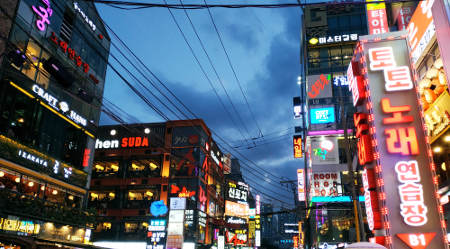 You can pretty much buy anything you need here. The smell of slowly cooked braised spicy pork draws me into a small restaurant and a feast ensues for a paltry £6.50. An evening of torrential rain the next day, doesn't stop me from venturing out for my evening meal. Fortunately the hostel provided slippers in the style of foam sliders which turned out to be the perfect footwear for the partially flooded streets. Did I look like an idiot......yes.....oh the price we pay for good food!
You can pretty much buy anything you need here. The smell of slowly cooked braised spicy pork draws me into a small restaurant and a feast ensues for a paltry £6.50. An evening of torrential rain the next day, doesn't stop me from venturing out for my evening meal. Fortunately the hostel provided slippers in the style of foam sliders which turned out to be the perfect footwear for the partially flooded streets. Did I look like an idiot......yes.....oh the price we pay for good food!Gyeongju (South Korea)
A short 1 hour 15 minute, £4 train journey from Daegu has me arriving in the centre of town with only a 5 minute walk to the hostel.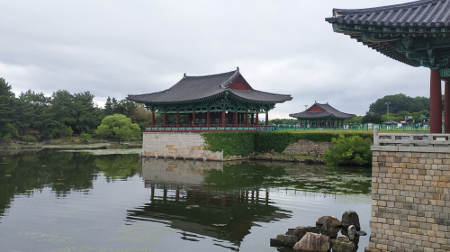 This small town is another UNESCO heritage site with many historical archaeological sites with original and reconstructed buildings, tombs perfectly covered in a round mound of earth & grass and working villages. It is fairly easy to walk around the main sites in and around town with local buses available for the further away historical sites which are usually under 30 minutes away.The town is a place of contrasts with a compact pedestrian downtown shopping and entertainment area and sweeping countryside moments away so you can experience the best of both worlds. 1-2 days is sufficient to see everything at pace, with 3 days making a more relaxed experience. The region is known for their local bread, with one type stuffed with bean paste, but tastes sweet.
This small town is another UNESCO heritage site with many historical archaeological sites with original and reconstructed buildings, tombs perfectly covered in a round mound of earth & grass and working villages. It is fairly easy to walk around the main sites in and around town with local buses available for the further away historical sites which are usually under 30 minutes away.The town is a place of contrasts with a compact pedestrian downtown shopping and entertainment area and sweeping countryside moments away so you can experience the best of both worlds. 1-2 days is sufficient to see everything at pace, with 3 days making a more relaxed experience. The region is known for their local bread, with one type stuffed with bean paste, but tastes sweet.Busan (South Korea)
I choose to take the bus south to Busan as the train journey involves going back to Daegu. Another very cheap (£3.70) and quick (50 min) journey south leads me to the second largest city with a population of 3.5 million.I stayed in the Nampo area near the port. My first impression as I walk around is that it's a bustling city, much more gritty than Daegu or Seoul.A visit to the largest fish market in South Korea is a must. Jagalchi Market has a huge selection of live shell fish including clams, huge crabs, oysters, octopus and tiny eels which can be all be eaten at the restaurants upstairs. Unfortunately they are tourist traps for westerners and visiting Koreans. I went on a walkabout and found a tiny place not far away grilling fresh fish which I simply pointed to and placed my order. The waitress had to ask a man whether he would mind sharing his table with me. He agreed and as soon as I sat down we started talking in broken English.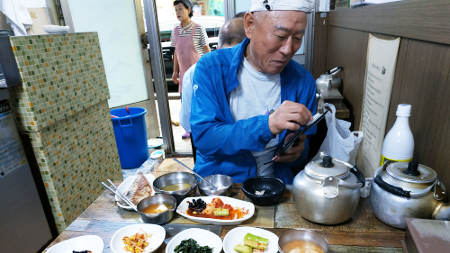 It turned out that he was a 72 year old retired university professor specialising in business. He explained his son was at Kingston University in the UK and that he had travelled extensively when younger. He proceeded to pay for my meal despite my protestations. I will in due course "pay it forward". The strange thing is that earlier in the day I was finding it difficult to find an ATM that would accept my card and was worrying about how I would pay for dinner that night......spooky!I decide to visit the colourful houses of Gamcheon Village early one morning. As I walk west from the centre of Busan, my estimates of an hour long walk quickely evaporates.
It turned out that he was a 72 year old retired university professor specialising in business. He explained his son was at Kingston University in the UK and that he had travelled extensively when younger. He proceeded to pay for my meal despite my protestations. I will in due course "pay it forward". The strange thing is that earlier in the day I was finding it difficult to find an ATM that would accept my card and was worrying about how I would pay for dinner that night......spooky!I decide to visit the colourful houses of Gamcheon Village early one morning. As I walk west from the centre of Busan, my estimates of an hour long walk quickely evaporates. It soon developes into a hike working my way into the forest behind the village with excellent views across Busan. 4km later, I eventually make my way downhill, ending up at Songdo Beach to enjoy a refreshing fruit shake. Another 4km back to my hostel proves interesting as I weave in and out of the port, ending up close to the huge fishing boats. After 4 days in Nampo I take the metro to Haeundae Beach (1 hour/22km) area of Busan. A huge curved, wide sandy beach with 90 storey new apartment blocks, is not what I was expecting. The beach gets busier as the day progresses. Fog stops me having my usual early beach walk, instead I have a long late afternoon walk, the water is surprisingly cold, but that doesn't stop kids having a wail of a time. This pretty much concludes the Korean segment of my trip with thoughts of amazing street food and an efficient and cheap transportation system.
It soon developes into a hike working my way into the forest behind the village with excellent views across Busan. 4km later, I eventually make my way downhill, ending up at Songdo Beach to enjoy a refreshing fruit shake. Another 4km back to my hostel proves interesting as I weave in and out of the port, ending up close to the huge fishing boats. After 4 days in Nampo I take the metro to Haeundae Beach (1 hour/22km) area of Busan. A huge curved, wide sandy beach with 90 storey new apartment blocks, is not what I was expecting. The beach gets busier as the day progresses. Fog stops me having my usual early beach walk, instead I have a long late afternoon walk, the water is surprisingly cold, but that doesn't stop kids having a wail of a time. This pretty much concludes the Korean segment of my trip with thoughts of amazing street food and an efficient and cheap transportation system.HOMEPAGE